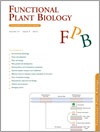
Functional Plant Biology
Volume 41 Number 8 2014
FP13351Retrotransposon-based molecular markers for assessment of genomic diversity
Retrotransposons (RTs) are major components of most eukaryotic genomes. Molecular markers play an essential role in all aspects of genetics and genomics, and RTs represent a powerful tool compared with other molecular and morphological markers. Here, we review the utility of some PCR retrotransposon-based molecular markers, including inter-primer binding sequence (IPBS), sequence-specific amplified polymorphism (SSAP), retrotransposon-based insertion polymorphism (RBIP), inter retrotransposon amplified polymorphism (IRAP) and retrotransposon-microsatellite amplified polymorphism (REMAP).
FP13265SsHKT1;1 is a potassium transporter of the C3 halophyte Suaeda salsa that is involved in salt tolerance
K+ nutrition plays a critical role in plants under salinity. We have characterised a potassium transporter, SsHKT1;1, from the euhalophyte Suaeda salsa L. and provide molecular and physiological evidence that it plays pivotal role in salt tolerance in halophytes such as S. salsa. These results will pave the way for improving the salt tolerance of crops by genetic engineering.
FP13222Cytosolic alkalisation and nitric oxide production in UVB-induced stomatal closure in Arabidopsis thaliana
Although stomatal movement is regulated by UVB radiation, the underlying mechanism is unclear. The data presented here show that both cytosolic alkalisation and NO participate in UVB-induced stomatal closure, and indicate that NO generation is elicited following cytosolic alkalisation and regulates cytosolic alkalisation via feedback. These findings help us gain further insights into UVB signalling, and the interaction of cytosolic alkalisation and NO production during multiple stimuli-triggered signalling in plants.
FP13300Water uptake and redistribution during drought in a semiarid shrub species
In arid systems, plants die during long drought periods and their performance may depend on their use of episodic rain events. Water from these events is often rapidly lost to evaporation but plants may draw it to deep soil layers, storing it to prevent evaporation and to allow for an efficient use. This mechanism supports longer plant survival and may be of great relevance in dry environments.
FP13278Photosynthesis–nitrogen relationships in tropical forest tree species as affected by soil phosphorus availability: a controlled environment study
Tropical forests play a vital role in the global carbon cycle and there is growing evidence that here, phosphorus (rather than nitrogen) may be the key nutrient limiting photosynthetic rates. In a greenhouse study of Australian tropical tree species, we found that phosphorus limitation reduced photosynthetic capacity and altered nitrogen use. The results underline the importance of phosphorus effects for future studies of tropical forest productivity.
FP13334Leaf shape influences spatial variation in photosynthetic function in Lomatia tinctoria
It is not yet known why leaf shape varies so widely among different plant species, but plant biologists suspect one reason might relate to different adaptations for optimal water delivery to and within leaves. This study showed that in response to extreme short-term water stress, photosynthetic function was more spatially uniform in broad-shaped leaves, despite the lower density of water conducting veins to support photosynthesis, relative to narrow-shaped leaves. These findings suggest that the spatial arrangement of veins alone is partially responsible for different stress responses in contrasting leaf shapes.
FP13284Limited photosynthetic plasticity in the leaf-succulent CAM plant Agave angustifolia grown at different temperatures
We tested whether growth of Agave angustifolia is reduced at high night temperatures as has been reported for many other succulents from habitats with pronounced day-night temperature variations. The persistence of appreciable rates of water-conserving dark CO2 fixation even at high day and night temperatures demonstrates the potential of this Agave, and perhaps others like it, for biomass production in seasonally-dry landscapes.
FP13212Physiological controls of the isotopic time lag between leaf assimilation and soil CO2 efflux
The dynamics of recently assimilated carbon are a key driver of the carbon budget of terrestrial ecosystems and of their response to global change. Our study shows that belowground transfer of photosynthates is related to plant physiological controls, which, unlike environmental controls, are still poorly characterised. Our study contributes to improve the understanding of the dynamics of carbon allocation and isotopic signatures in terrestrial ecosystems.
FP13233Evaluating growth platforms and stress scenarios to assess the salt tolerance of wheat plants
Selection of crops under saline conditions has been notoriously difficult. Simplified platforms and stress scenarios are used too often to evaluate the salt tolerance and to extrapolate to real field conditions. We evaluated growth platforms and stress scenarios and conclude that a combined salinity + drought stress scenario and a reliable growth platform are of utmost importance in screening for salt tolerance.
FP13156Evaluating the potential of a novel dual heat-pulse sensor to measure volumetric water use in grapevines under a range of flow conditions
Accurate quantification of crop water use is needed for efficient irrigation management in dry growing regions. We evaluated how well a novel application of sap-flow sensor technology measures grapevine water use, and found that flow rates measured with these new sensors correlated well other methods of water use quantification. This technology has potential use in irrigation management and research settings.
FP13343Fruit presence negatively affects photosynthesis by reducing leaf nitrogen in almond
Fruiting in many tree species is known to impact productivity in subsequent years. In this research we tested whether almond fruit competes with leaves for nitrogen and hypothesised how this would impact leaf carbon assimilation rates through the season. The results showed that almond cannot supply sufficient nitrogen simultaneously to fully satisfy the demands of leaves and fruits born in the same spur (principal bearing structure of almond trees).



